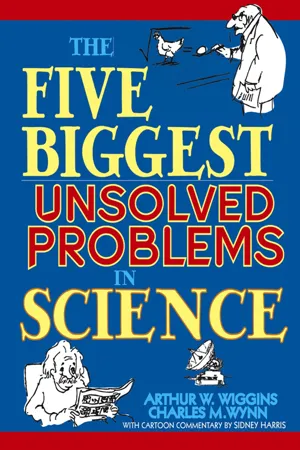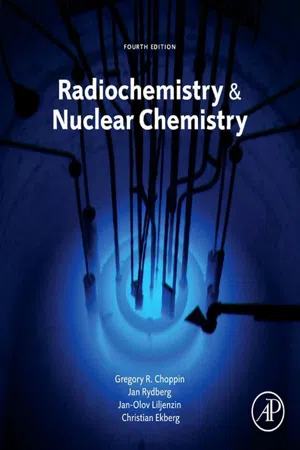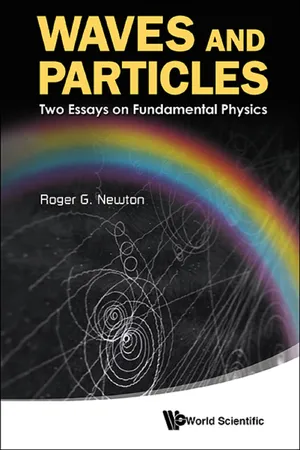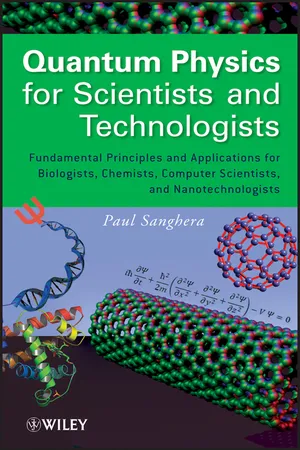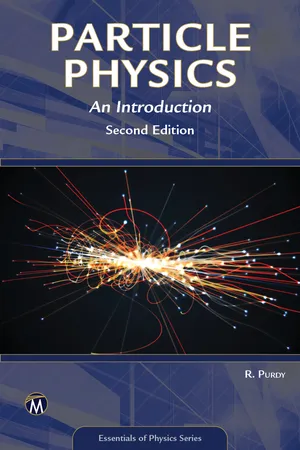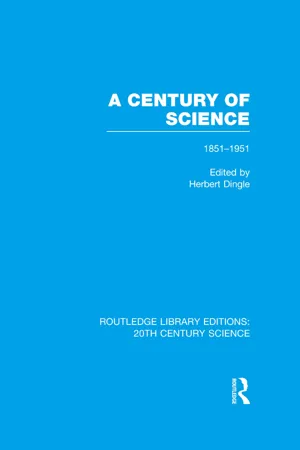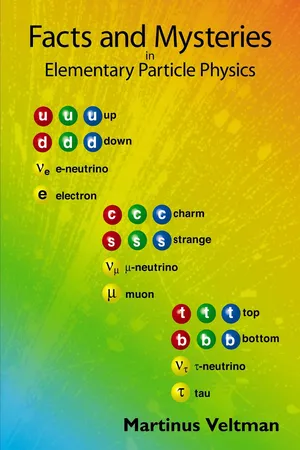Physics
Particles
Particles are tiny units of matter that make up the universe. They can be classified as either elementary particles, which are the building blocks of matter, or composite particles, which are made up of smaller particles. In physics, the study of particles helps to understand the fundamental forces and interactions in the universe.
Written by Perlego with AI-assistance
Related key terms
Related key terms
1 of 4
Related key terms
1 of 3
10 Key excerpts on "Particles"
- eBook - ePub
- Andrew Rex(Author)
- 2014(Publication Date)
- CRC Press(Publisher)
Chapter 8Fundamental Particles and Forces
Some of the most exciting recent discoveries in physics have to do with fundamental Particles. For many centuries people have observed matter and wondered about its composition. A common working assumption, which goes back as far as the ancient Greeks, is that there exists a relatively small number of elementary or fundamental Particles, and that the vast variety of things we see in nature can be explained by different arrangements of those few Particles. Starting in the late nineteenth century, physicists began to develop the kinds of experimental tools that can determine the ultimate composition of matter. Throughout the twentieth century, more refined and elaborate equipment revealed many details about the Particles that make up everything. Patterns began to emerge and, based on those patterns, theories were developed to help physicists classify and understand the Particles’ properties and their interactions with one another. Along with this came a new conception of fundamental forces as the manifestations of particle exchanges. The connection between fundamental Particles and forces is one of the most important discoveries in modern physics.What Are Fundamental and Composite Particles?
The idea of a particle may seem obvious enough. You might consider as an example the smallest thing you can see, such as a grain of dust or pollen. However, those objects are very large compared to what a physicist thinks of as a particle. Your vision is limited by the focusing power of your eyes, and even when aided by a good microscope, you can’t see detail finer in size than the wavelength of the light you’re using to view the object. Atoms are much smaller than a grain that you can see, and fundamental Particles are much, much smaller than atoms.A fundamental particle is one that can’t be broken down into anything smaller. A composite particle - eBook - ePub
- Arthur W. Wiggins, Charles M. Wynn(Authors)
- 2008(Publication Date)
- Trade Paper Press(Publisher)
CHAPTER TWOPHYSICS
Why Do Some Particles Have Mass while Others Have None?
The baby figure of the giant mass Of things to come at large.—William Shakespeare ,Troilus and CressidaPhysics is the study of the properties of matter at rest and in motion and of various forms of energy. Motion-related properties such as velocity, acceleration, and momentum are well understood, as are kinetic and potential energy. What is not understood is the nature of mass, a property of most forms of matter. In fact, the origin of mass is currently the biggest unsolved problem in physics.Mass
We are all too familiar with the fact that mass exists. Mass is self-evident. We all seem to have too much or too little of it. Mass is what makes it harder to push a stalled car than a baby carriage. Mass is what gravity tugs on to keep us grounded on planet Earth.What is not at all clear is the origin of mass. Many, but not all, of the fundamental Particles in the universe have mass. Why do some have mass, while others have none? What “gives” mass to some Particles and not others? Among Particles with mass, why do some have more mass than others? Do Particles without mass lack something else besides mass? The answers to these questions may lie in something called the Higgs field, but we’ll need some background information before we can make sense of the elusive Higgs field.To begin with, we know that a body’s mass is related to the amount of matter it contains, and we have a pretty good idea of what forms matter: collections and combinations of atoms. But what forms the atoms? Atoms are composed of electrons, protons, and neutrons. But what forms the electrons, protons, and neutrons? Electrons are fundamental (not composed of “anything else”), but protons and neutrons are not. They are made of quarks, and it is quarks and electrons that appear to be truly fundamental.Before we can discuss the unsolved nature of mass, we’ve got to see where quarks came from. (See Figure 2.1.) In the process, we’ll run across a few other fundamental Particles, we’ll see that fields are regarded as even more fundamental than Particles, and we’ll investigate physics’ best field theory, called the Standard Model. Next we’ll note the inadequacies of the Standard Model: It doesn’t identify the source of mass, and it omits gravity entirely. Finally, we’ll explore theories beyond the Standard Model that would solve the problem about mass’s origins. - eBook - ePub
- Gregory Choppin, Jan-Olov Liljenzin, Jan Rydberg, Christian Ekberg(Authors)
- 2013(Publication Date)
- Academic Press(Publisher)
Annual report 1961 , CERN).This has created a scientific area called elementary particle physics . It is quite different from nuclear physics, which is concerned with composite nuclei only. A principal objective of elementary particle physics has been to group the Particles together according to their properties to obtain a meaningful pattern, which would describe all Particles as parts of some few fundamental building blocks of nature. One step in this direction is to study how the elementary Particles interact with each other, i.e. what kind of forces are involved.Scientists have long doubted that all the Particles produced with masses between the electron and the proton (loosely referred to as mesons , i.e. “intermediate”), and with masses greater than the proton (referred to as baryons , “heavy”) really are “elementary”. It was proposed that they have a substructure or constitute excited states of each other. Are they waves or Particles since they serve as carriers of force? At this point it is important to understand what is meant by “particle” in nuclear physics.2.2 Forces of Nature
Considering what an immense and incredible diverse assembly the universe is – from the cosmos to man and microbes – it is remarkable that scientists have been able to discover with certainty only four basic forces, which govern the attraction and repulsion of all physical objects of nature. Let us consider these forces of nature in a qualitative way from the weakest to the strongest, see Table 2.1 .Table 2.1 Forces of nature in order of strength and their exchange Particles† Not yet detected.The first and weakest force of nature is that of gravity . The gravitational force, F g , beween two masses, m 1 and m 2 , at a distance r is given by eqn (2.1) , where G is the universal constant of gravity (G = (6,6742 ± 0,0007) × 10–11 N m2 kg–2 - eBook - ePub
Waves And Particles: Two Essays On Fundamental Physics
Two Essays on Fundamental Physics
- Roger G Newton(Author)
- 2014(Publication Date)
- WSPC(Publisher)
Part IIParticles
Passage contains an image
Introduction to Part II
The first essay of this book was concerned with an aspect of one of the most basic subjects of physics, the dynamics of the world, namely waves, waves that arise as natural phenomena or govern human communication. This second essay is going to deal with another basic subject, namely the structure of the world: the fact that the world is made up mostly of Particles.How and when did we find out about this fact? These Particles are so tiny that nobody has ever actually seen them.What kind of Particles are they and what are their properties? It will turn out that, whereas for millennia philosophers had speculated about the existence of atoms, after scientific evidence for the existence of atoms was actually found, they were not simply indestructible little entities as had been thought, but they have a non-trivial structure, including a nucleus at the center.After describing what nuclear physics is all about, we turn to the discovery of other Particles, some of whose existence had been predicted by new theories. After that, the search for new Particles really took off, and the instruments required for this search became enormously large. What are accelerators for, and why do they have to be so huge and expensive?The search for new fundamental Particles became so successful that physicists had to devise methods to make sense of this confusing conglomeration. They even had to learn unfamiliar mathematical procedures that had been invented for completely different purposes but turned out to be indispensable. In the end, the new classification methods became just as useful for physicists as the invention of the periodic table of the elements was for chemists, and they led to many new insights. All of this will be described in this essay in a way that should be accessible to readers with no mathematical background knowledge. - eBook - ePub
Quantum Physics for Scientists and Technologists
Fundamental Principles and Applications for Biologists, Chemists, Computer Scientists, and Nanotechnologists
- Paul Sanghera(Author)
- 2011(Publication Date)
- Wiley-Interscience(Publisher)
The explanation of experimental results from black-body radiation and the photoelectric effect, discussed in Chapter 2, pointed to the particle-like behavior of electromagnetic (EM) waves and perhaps to the fact that EM waves are composed of Particles. Most scientists at the time of these discoveries took these explanations as mathematical tricks more than a physical reality. As you saw in Chapter 2, it took a couple of decades for the reality to set in, with the proposal from Compton that EM waves (light) actually consist of Particles that he called photons. Around that time, believing in the generality, symmetry, and universality of the physical law, a graduate student named Louis de Broglie took a leap in the reverse direction by presenting the hypothesis that there is a wave (or a wave group) associated with each particle. This hypothesis, which withstood the experimental scrutiny, led to the particle–wave duality of matter, which in turn gave rise to the famous Heisenberg uncertainty principle; a cornerstone of modern science.So, the three underlying streams of thought in this chapter are wave properties of Particles, wave–particle duality of matter, and the uncertainty principle. 3.2 Particles AND WAVES: THE BIG PICTUREAll matter is composed of atoms, which in turn are made up of protons, neutrons, and electrons: the subatomic Particles. Protons and neutrons exist in the nucleus of the atoms, and electrons are configured around the nucleus. This configuration along with the number of protons and neutrons in the nucleus determine the atomic structure and the properties of the atoms and the corresponding elements, such as metals and nonmetals. In the classical picture, electrons, like protons and neutrons, are considered Particles just like light is considered a wave.In Chapter 2, you learned that light, which is classically a wave, could behave as Particles. A natural question to ask is Could it be that electrons (and other Particles for that matter) could behave as waves? If yes, what would it mean and what are the implications? This chapter is an answer to this question. - eBook - ePub
- Kenneth W. Ford, Paul Hewitt(Authors)
- 2011(Publication Date)
- Harvard University Press(Publisher)
section VIII And More Particles44. Names, names, names. What do they all mean? One of the impediments to learning about Particles is nomenclature. There is a confusing array of names, some of them whimsical. Here is a glossary of some of the terms used by particle physicists. It should help as a reference point. Some of these terms have appeared in earlier sections; some appear in this and later sections.Leptons— Fundamental Particles of spin ½ that do not feel the strong interaction. There are six leptons: three of charge −1 (electron, muon, and tau), and three that carry no charge (the electron neutrino, muon neutrino, and tau neutrino).Quarks— Fundamental Particles of spin ½ that do feel the strong interaction. There are six quarks: up, down, charm, strange, top, and bottom. The up, charm, and top quarks have charge +2 ⁄3 . The down, strange, and bottom quarks have charge −1 ⁄3 . Quarks are never seen in isolation. They combine in twos or threes to make hadrons.Force carriers— Fundamental particle of spin 1 that mediate interactions. There are eleven force carriers: the W (with positive and negative manifestations) and Z0 , which mediate the weak interaction; the photon, which mediates the electromagnetic interaction; and eight gluons, which mediate the strong interaction. (There is also a theoretical graviton, of spin 2, that mediates the gravitational interaction but—so far—plays no role in the particle world.) Force carriers are also called exchange Particles.Flavor— An arbitrary name used to sort out different kinds of leptons and quarks. Leptons have three flavors. Each charged lepton and its associated neutrino constitute one flavor. All six quarks are assigned different flavors. (The words family and generation have also been used to segregate the different kinds of fundamental fermions. )Color— An arbitrary name used to sort out different forms in which each quark can manifest itself. There are three colors, conventionally called red, green, and blue - eBook - ePub
From Atoms to Higgs Bosons
Voyages in Quasi-Spacetime
- Chary Rangacharyulu, Christopher J. A. Polachic(Authors)
- 2019(Publication Date)
- Jenny Stanford Publishing(Publisher)
Chapter 7When Is an Atom? 1
Science has explained nothing; ...the more we know the more fantastic the world becomes and the profounder the surrounding darkness....—Alduous HuxleyAlong the Road: Notes and Essays of a Tourist (1925)7.1 The Classical Atom
During the recent decades, it has become clear that there is no unique, objective physical characteristic that allows us to decide when we should and should not call an entity a fundamental particle ,2 except, perhaps, that the community of particle physicists agrees to do so. This has not always been the case and is, in fact, a recent development in the history of physics. The concept of a particle, whether fundamental or not, has dissolved over time as developments in physics have rendered the concept inherently ambiguous.Nearly 3000 years ago, natural philosophers conceived of the basic material of the physical world in terms of four or five fundamental elements. The candidates were earth, air, water, fire, wind, metal, wood, and quintessence 3 or aether . Which four or five elements were accepted by the community of philosophers or larger society was closely linked to many factors, including their cultural and religious beliefs, mythologies, understanding of physical processes, and geographical context. The microscopic structure of the elements required further consideration, and two competing views were commonly held: a plenary theory, in which matter contains no voids and can be divided into smaller pieces without end; and an atomic theory, in which the elements can be broken down only to a certain finite limit, where we encounter the fundamental pieces that form physical things: atoms .As discussed in the first chapter of this book, the Greek atomists are now remembered as the originators of this atomic theory, and Democritus is renowned as the chief expositor. A few characteristics of his atoms may be reviewed: - eBook - ePub
Essentials of Physics Series
An Introduction
- Robert Purdy(Author)
- 2022(Publication Date)
- Mercury Learning and Information(Publisher)
CHAPTER 1 A H ISTORY OF P ARTICLE P HYSICS This chapter is intended to provide the reader with an overview of the history of particle physics, but that is not its only function. Along the way, some of the key concepts in the field will be touched upon in such a way as to prepare the reader for later chapters, when we will revisit these concepts and put them on a firmer footing. 1.1. ATOMIC THEORY A history of particle physics must start somewhere, and this one starts with Isaac Newton. We could go back to Ancient Greece and talk about the philosophical arguments regarding whether or not matter was infinitely divisible, but we will avoid this for two reasons. First, such matters have been considered in the philosophies of various world cultures, and the author does not wish to be accused of Eurocentrism. Second, and more importantly, the following is a history of the scientific study of the particle nature of reality, and science itself only surfaced as a discipline in its modern form much later, in the fifteenth and sixteenth centuries. Newton believed that light is composed of a stream of Particles, which he called corpuscles. Though this idea was not originally Newton’s, he developed it and showed that it was able to correctly model the laws of reflection and refraction, along with other optical phenomena. The big problem with Newton’s corpuscular theory, though, was that it failed when one attempted to apply it to the diffraction and interference of light. For this reason, over time, it was gradually realized that an older, rather more conceptually difficult theory was better suited to describing the nature of light. This was the wave-front theory put forward by Christian Huygens 26 years before Newton’s model, which models light as a wave propagating through space - eBook - ePub
- Herbert Dingle(Author)
- 2014(Publication Date)
- Routledge(Publisher)
CHAPTER IIIPARTICLE PHYSICS
by H. T. FLINT , PH. D., D.SC.ALTHOUGH matter on a large scale gives to the senses the impression that it has a continuous structure, theories that matter can be divided and sub-divided indefinitely have not met with success. From early times the alternative view has been held that matter consists of a collection of indivisible Particles which, being extremely small, give the appearance of continuity on a large scale. This is the view which forms the foundations of the theories of chemistry and physics today, but until a little more than a hundred years ago this theory of matter was on the whole only qualitative.Then, in the early days of the nineteenth century, the work of Dalton laid the foundations of a quantitative atomic theory. During these years he published his view that the atoms of a particular clement were identical in all respects but differed from those of other elements. He considered that chemical combinations occurred in simple numbers of atoms—one to one or one to two, and so on—and this was supported by the quantitative laws of chemistry which were just then being experimentally established.The fact that some atomic weights are very nearly integral multiples of that of hydrogen led Prout in 1815 to suggest that the atom of hydrogen was the fundamental particle from which all elements were constructed. Nothing smaller than this atom was at that time contemplated. There are some very marked deviations from this integral relation amongst the chemical elements and Prout’s hypothesis was for a long time left aside. More recent discoveries and developments have led to a correct interpretation of it, and its significance as an essential law in the theory of matter is now understood. - Martinus J G Veltman(Author)
- 2003(Publication Date)
- WSPC(Publisher)
The Particle Zoo 8.1 Introduction Around 1960 the situation in particle physics was very confusing. Elementary Particles a such as the photon, electron, muon and neutrino were known, but in addition many more Particles were being discovered and almost any experiment added more to the list. The main property that these new Particles had in common was that they were strongly interacting, meaning that they would interact strongly with protons and neutrons. In this they were different from photons, electrons, muons and neutrinos. A muon may actually traverse a nucleus without disturbing it, and a neutrino, being electrically neutral, may go through huge amounts of matter without any interaction. In other words, in some vague way these new Particles seemed to belong to the same group of Particles as the proton and neutron. In those days proton and neutron were mysterious as well, they seemed to be complicated compound states. At some point a classification scheme for all these Particles including proton and neutron was introduced, and once that was done the situation clarified considerably. In that era theoretical particle physics was dominated by Gell-Mann, who contributed enormously to that process of systematization and clarification. The result of this massive amount of experimental and theoretical work was the introduction of quarks, and the understanding that all those ‘new’ Particles as well as the proton and neutron were various bound states of quarks. So this is what this Chapter is about: bound states of quarks. There are many of them, and they form what we may call the particle zoo. They are Particles, but not elementary Particles. Some of them have been mentioned before, namely pions and kaons. Luis Alvarez (1911–1988). After Glaser came up with the idea of a bubble chamber Alvarez was quick to realize the potentialities of such an instrument. With considerable energy he put himself to the task of building bubble chambers, and to use them for physics purposes
Index pages curate the most relevant extracts from our library of academic textbooks. They’ve been created using an in-house natural language model (NLM), each adding context and meaning to key research topics.
Explore more topic indexes
Explore more topic indexes
1 of 6
Explore more topic indexes
1 of 4

